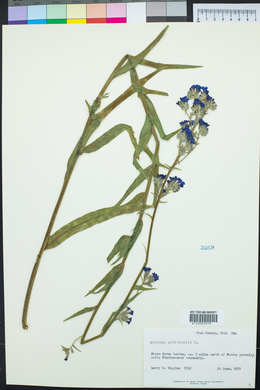Anchusa officinalis
|
|
|
|
Family: Boraginaceae
Common Bugloss
|
Perennial herb 30 - 80 cm tall Leaves: alternate, usually more than 2 cm wide, non-toothed, bristly-hairy. The lower leaves are stalked, inversely lance-shaped (widest above the middle), and 6 - 20 cm long. Upper leaves stalkless, lance-shaped (widest below the middle), and decreasing in size upwards. Inflorescence: terminal, usually of several, compact, short, sometimes curved, forked, spike-like clusters subtended by leafy, lance-shaped or elongate-triangular bracts, and the flowers on short, erect or ascending stalks. Flowers: blue, mostly under 1 cm tall, 0.6 - 1 cm broad, radially symmetric, tubular to narrowly funnel-shaped with short, ascending to somewhat spreading lobes. Sepals: coarsely bristly, five, but fused into a 5 - 7 mm long tube (at least half their length) with hairy scales in the throat, then separating into narrowly triangular (more than three times longer than wide), pointed lobes. Petals: blue, five, but fused into a 0.6 - 1.1 cm long tube, then separating into short, ascending to somewhat spreading, round-tipped lobes. Stamens: five, attached inside to upper part of petal tube, but not exceeding the tube in length. Pistil: with one, strongly four-lobed, superior ovary, and single style and stigma. Fruit: a cluster of four, wrinkled, bumpy (but not prickly), short (about 2 mm tall), 3 - 4 mm long, egg-shaped nutlets with a thickened rim around the base. The four nutlets are arranged nearly horizontal around the remnant style base on top of a disk-like platform with the narrowed, inner tips of each nutlet pointing toward the center and slightly raised compared to their outer edge. Root: a taproot. Stems: often several, upright, leafy, and covered with spreading, stiff hairs. Similar species: Anchusa officinalis is somewhat similar to Symphytum asperum and S. officinale, but those species have leaves that are a bit larger, and flowers that are paler, more bell-shaped with longer, cylinder-shaped tubes and very short lobes. Symphytum officinale further differs by having leaves with basal tissue continuing onto the stem as wings, the inflorescence is more axillary, and the nutlets are smooth and not wrinkled. Two other non-native species of Anchusa occur in the eastern United States: A. azurea which has taller (5 - 9 mm) nutlets arranged upright with tips erect, and A. arvensis, an annual that differs because its flower tube is curved or bent and the lobes are somewhat unequal in size. Flowering: June to September Habitat and ecology: In waste places as a rare escape from cultivation. Occurence in the Chicago region: non-native Notes: This species is native to the Mediterranean. Author: The Field Museum Taprooted, spreading-hirsute perennial 3-8 dm, often several-stemmed; lower lvs oblanceolate, petiolate, mostly 6-20 cm (petiole included) נ1-1.5 cm, the others gradually reduced, becoming sessile and more lanceolate; bracts lanceolate or lance-triangular; cal 5-7 mm at anthesis, scarcely longer in fr, the lanceolate or narrowly triangular lobes about equaling or a little longer than the tube; cor-tube 6-11 mm, the limb 6-11 mm wide; stamens inserted in the upper part of the tube; nutlets ±rugose and tuberculate, oblique, 2 mm high and 3-4 mm long, the tip directed inward; 2n=16. Native of the Mediterranean region, now found as an occasional weed in much of our range. Gleason, Henry A. & Cronquist, Arthur J. 1991. Manual of vascular plants of northeastern United States and adjacent Canada. lxxv + 910 pp. ©The New York Botanical Garden. All rights reserved. Used by permission. |









































































